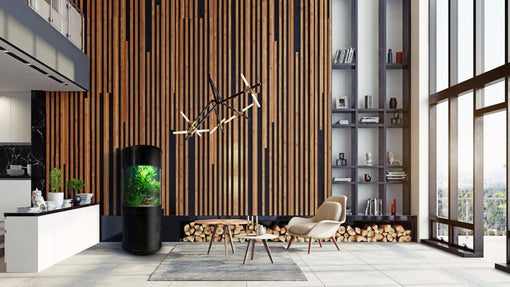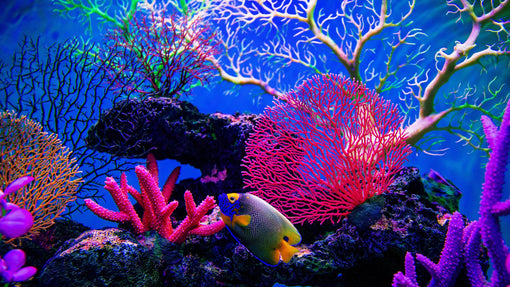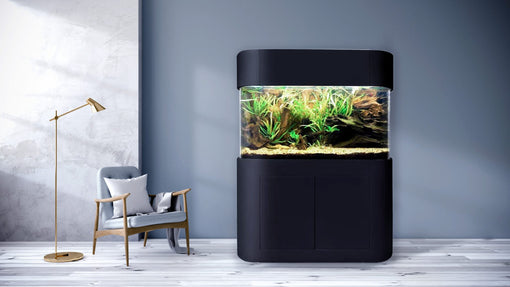
It’s so relaxing to watch a reef tank. It’s like a living work of art, the beautiful fish leisurely swimming, the muted colors of the rocks and the corals. It makes sense that you would want to recreate that in your home.
If you’re new to building and maintaining a glass home aquarium, setting up something as specialized as a reef tank might seem a little scary. With the right resources, starting your first reef tank doesn’t have to be intimidating.
When it comes to starting a reef fish tank, just figuring out where to start can be overwhelming. There are definitely some important things you need to know about starting a reef fish tank. We’ll get you on the right path, and answer questions you didn’t even know you had. We do have one warning, once you dive into the world of hobby aquariums, you’ll just keep going deeper!
Is A Saltwater Tank A Reef Tank?
Before you get started on your reef tank, there is an important distinction to make. All reef tanks are saltwater tanks, but not all saltwater tanks are reef tanks. A reef tank is just one of the varieties of saltwater aquariums you can create.
A reef tank mimics the environment of a natural reef system. It should include live rock, corals, reef fish, and the right types of invertebrates. In a natural reef system, the animals all benefit from one another and coexist peacefully. When you start building your reef tank, this is the environment you want to try to recreate.
Choosing The Right Reef Aquarium Equipment
Buying your fish, and building the reef is the most exciting part of the process for most people. Before you start buying equipment, you definitely need to have an idea of what you want living in your tank. Tank size, lighting, filtration, and if you’d rather get an all-in-one tank can all be influenced by your future tank residents.
Tank Size
It sounds backward but opt for the largest aquarium that will suit your budget and your space. Caring for larger aquariums and maintaining homeostasis is easier than dealing with the chemistry of a tiny tank, there is more margin for beginner error with larger tanks as well. As a bonus, the larger the tank, the more room you have to add corals, and fish.
Filtration, Lighting, and Heating
These are items you will need to research and source if you choose to build your own aquarium. You can also buy all-in-one reef-ready aquariums.
Filtration
Your filters are very important for removing the buildup of nitrates, ammonia, and other toxins that buildup in a tank. Live rock provides some natural filtration and invertebrates eat food debris that can contribute to toxins. Even with these biological cleaners, a mechanical filtration system is a must.
Lighting
Before you decide on lights, decide which types of corals you want for your tank. Lighting for your reef tank depends on the corals. Different varieties of corals have different lighting needs, and their health depends on the right lights. Halides and LEDs are best for reef tanks with corals. An accepted standard for lighting soft corals is 3.5 watts per gallon, while hard corals need 4.5 watts. Choosing your lighting is also very important because it can cause your aquarium to overheat, which will negatively impact all the creatures in your tank.
Heating
If you are building your own aquarium a heater is a must. There are numerous heaters on the market, and the type you choose can be based on your own preference.
Should you get an all-in-one aquarium?
There are pros and cons to building your own aquarium and to an all-in-one system. The all-in-one has everything you need to get started. They come fully equipped with a tank, lights, and filtration system. Building your own tank allows for more customization. It can also cost less than buying an all-in-one tank setup. It can take longer to get your tank up and running, just due to having to find all the parts. If you are a beginner, and even if you aren’t, an all-in-one tank system is a great way to get your reef tank started. It keeps things simple, and you won’t have to deal with the frustration of sourcing equipment. If you have experience, want to be able to upgrade your parts as new things become available, and have the time to do it, try building your own tank.
Choosing Reef Residents
Live Rock
Live rock is a critical part of your reef tank. Live rock is coral skeletons covered in algae and microorganisms. The nooks and crannies are filled with bacteria and tiny plants and animals that act as biological filters in your tank.
You can source love rock in several ways. You can purchase live rock that has been harvested directly from the ocean floor; these are available at aquarium stores and online. There are also artificial rocks that are not sourced from the ocean. As a third alternative, you can also make your own live rock.
Coral
You can’t have a reef without coral. Some corals can be very demanding, so it’s best to start with hardy types and work your way up. There are 6 types of coral.
- Small Polyp Stony (SPS)
- Soft Corals
- Large Polyp Stony (LPS)
- Zoanthids
- Mushrooms (Corallimorphs)
- Gorgonians
Each of these groups has hundreds, if not thousands of subspecies within them. Not all these corals are well suited to tank life. Of the corals that can thrive in an aquarium, some of the most beginner-friendly corals include:
- Green star polyps
- Mushroom Corals
- Button Polyps
- Kenya Tree Corals
Fish
When you choose fish for a reef tank, pick gentle fish that won’t harass or eat your corals. You also want fish that won’t try to eat each other. Look for fish that are labeled “Reef Safe”.
As you decide on fish, think about the different roles they will fill in your tank’s ecosystem. Some fish work well when paired together. Other fish get along best with certain types of coral. Look for fish that will have a mutually beneficial relationship with others in the tank.
Here are a few fish that are good for beginners:
- Clownfish
- Midas Blenny
- Firefish Goby
- Azure Damselfish
Invertebrates
Clams, crabs, worms, starfish. These are just a few of the invertebrates you can add to an aquarium. They add color, and they’re fascinating to watch. A reef tank isn’t complete without invertebrates.
Invertebrates aren’t just fun to watch in your aquarium. They act as a tiny janitorial crew. They’ll eat up detritus that falls to the tank floor. They help with parasite control and combined with the right fish help keep your reef tank algae free.
As with everything in a reef tank, you have to consider how your invertebrates will act with the other critters in the tank. Some saltwater invertebrates just aren’t right for a reef environment.
Some beginner-friendly invertebrates include:
- Scarlet cleaner shrimp
- Emerald Crabs
- Feather Duster
- Maxima Clam
Starting an at-home reef fish tank takes strategic planning and research. Don’t be afraid to ask experts and other hobbyists for their tips and tricks. Some of the best information you’ll get is from fellow reef tank hobbyists. Once you start designing and customizing your at home aquarium, you’ll be amazed at how quickly it all starts coming together, and at how satisfied you’ll be with the result. Contact our team of aquarium specialists to learn more about Aqua Vim’s luxury glass fish tanks for saltwater reef tanks.


